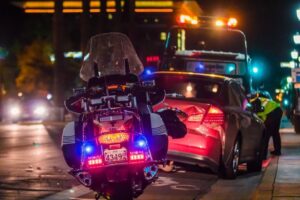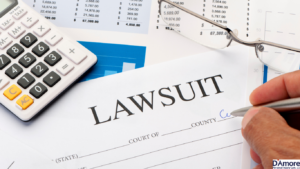
What Makes Motorcycle Accident Lawsuits Different?
Motorcycle riders have the same rights as all other road users, yet they are often overlooked or disregarded by other
D'Amore Personal Injury Law, LLC
Serious Injury Lawyers Proudly Serving
Baltimore, Annapolis, & Washington, D.C.
Red lights on traffic signals are not polite suggestions to stop if you have time. Stopping at a red light is the law in every state across the country. However, despite this fact, studies show at least two people die every day in accidents involving red-light runners.
Last year, the National Coalition for Safer Roads (N.C.S.R) reported 880 fatalities and 132,000 people who were injured after red-light accidents. The majority of these individuals were not the driver who broke the law, but the pedestrians, bicyclists, or surrounding drivers who suffered the consequences.
To help spread awareness of these careless red-light crashes, N.C.S.R. collaborates with organizations nationwide in the first full week of August to observe National Stop on Red Week. This safety campaign helps educate drivers on the prevalence of red-light runners and the importance of implementing safety measures to these accidents in your community.
Between 2004 to 2016, the N.C.S.R reported over 10,125 people were killed in red-light crashes. These accidents are entirely preventable and are most often caused by reckless behaviors such as distracted, fatigued, impaired, or aggressive driving.
Although red-light accidents can happen on any day, certain times of the year pose a higher risk than others. Data compiled from 120 red-light camera programs show the following trends:
More people participate in red-light running than we are comfortable believing. According to a survey performed by the AAA Foundation for Traffic Safety in 2017, 93 percent of drivers identified running red lights as unacceptable, but 43 percent of the same drivers admitted to doing it in the last 30 days.
Driving through a red light, turning right-on-red before stopping, or turning right-on-red where the action is not permitted categorizes a driver as a ‘red-light runner.’ These reckless behaviors take motorists, pedestrians, and bicyclists by surprise, as most people are not predicting that someone will be breaking an obvious law.
We all make mistakes on the road, but some of us make more reckless mistakes than others. According to the Insurance Institute for Highway Safety (I.I.H.S.) these types of drivers are more likely to adopt running a red-light as a dangerous habit:
Red-light cameras have been a controversial topic for Americans since the beginning. The first red-light camera program was implemented in 1992. Studies have shown that in large cities, these systems have reduced fatal red-light accidents by up to 23 percent.
Yet, even though the numbers show that red-light cameras save lives, the I.I.IH.S. a significant decline in these safety programs since 2012. Communities are in an uproar about system malfunctions and unnecessary hefty fines, putting a halt on the spread of red-light cameras to keep the peace. More programs have been discontinued than utilized, and it’s causing red-light fatalities to continue.
In full support of implementing more red-light camera programs across the country, the I.I.H.S. teamed up with AAA, the National Safety Council, and Advocates for Highway and Auto Safety to create a red light camera checklist. This list is the perfect tool to guide communities in the process of planning, implementing, and evaluating their red-light program to ensure it is successful with minimal errors.
Every driver has a responsibility to prevent causing harm to others on the road. Knowing the red-light traffic laws is the first step to reducing accidents that spawn from right-of-way confusion or a genuine misunderstanding of the rules. In Maryland, these are the laws all drivers should know:
Motorists who pull up to a solid or flashing red light must make a complete stop prior to reaching the line marking the crosswalk or intersection. If there is no crosswalk or line, the driver must stop before entering the intersection itself.
Maryland drivers may turn right on red after stopping at a red-light if the intersection or street allows it. Drivers must use caution and yield to right of way vehicles before making a turn on red.
One instance under Maryland law allows drivers to turn left-on-red: after stopping at a red light from a one-way street onto another one-way street. All other left-on-red turns are prohibited.
It is not illegal in Maryland to enter an intersection while the light is yellow. It is illegal to enter an intersection while trying to beat a yellow light, driving through a red light in the process.
There are several ways you can spread awareness during Stop on Red Week that could help keep everyone in your community safe.
All information has power. Spread the word on the issue of red-light accidents by hitting social media. N.C.S.R. provides pre-written posts, and images advocates can use to educate their follower on statistics pertaining to red-light crashes and fatalities. Supporters can also use #StopOnRed2019 and #StayAlertStayAlive to join a larger online fight against these preventable accidents.
Attend a local town or city council meeting to get involved in what your community is doing in regard to street safety. Advocate for the addition of red-light cameras and extended yellow light signals to reduce the number of unnecessary tragedies in intersections known for accidents. Find out where your red-light accidents are most likely to happen and consider placing special signs to remind drivers to stop.
Get your co-workers, family members, and friends to take the pledge to stop on red. Hold each other accountable for safe driving behaviors and protecting the people in your community every time you are behind the wheel.
Remember, breaking a traffic law can cost you more than just a hefty fine. It could mean taking someones life. Don’t take the chance- stop on red!
Our Maryland accident lawyers have the trial experience to protect your rights and fight for the compensation you need and deserve. Don’t Get Mad… Get Justice! Call 1-800-JUSTICE or fill out an online contact form to get the justice you deserve. You will reach one of our successful accident attorneys to review your case. Our consultation is free, and there is no fee unless we win!
Fill out the form below and we will contact you.
Or, give us a call at

Motorcycle riders have the same rights as all other road users, yet they are often overlooked or disregarded by other

Understanding Medical Malpractice Settlements in Maryland Medical malpractice cases can be emotionally and financially devastating for victims and their families.

How Long Does It Take to Settle a Traumatic Brain Injury Case in Maryland? Traumatic brain injuries (TBIs) can have